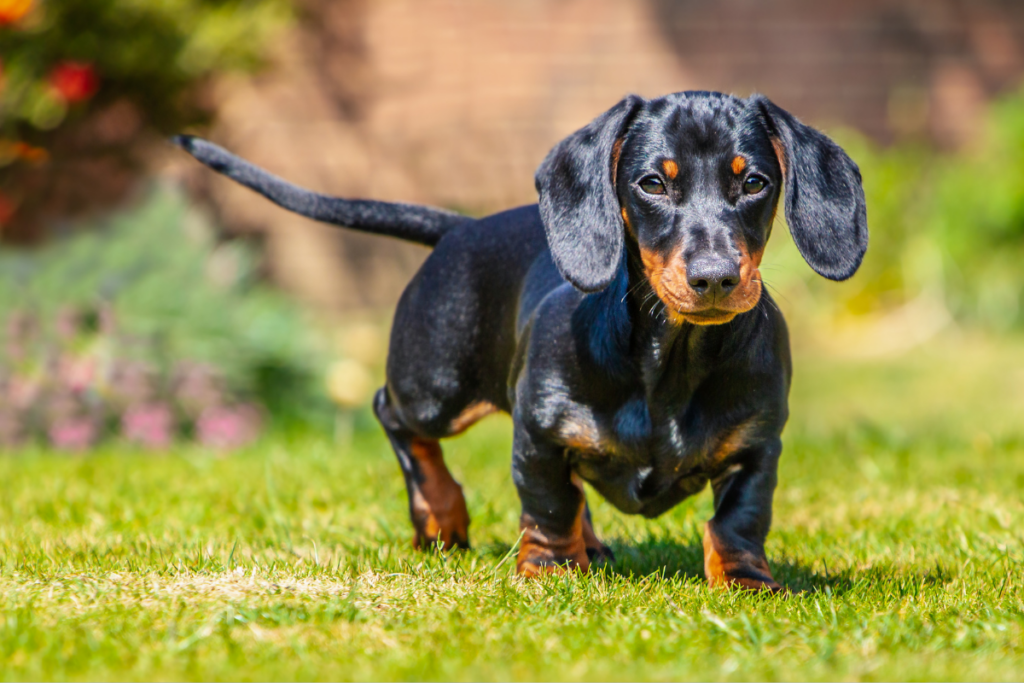Dachshunds are an easily recognized breed who can’t help but bring a smile to people’s faces. Their signature long and low bodies have given them many nicknames like ‘weiner dog’, ‘low rider’, and ‘sausage dog’, and their bold and determined personalities have won them many fans. Dachshunds come in two sizes and a variety of colors and coat patterns. The standard dachshund is about 8-9 inches tall and weighs from 16-30 pounds. The miniature dachshund stands only 5 or 6 inches tall and weighs in at under 11 pounds. Although they are small, dachshunds are not delicate. They are well-muscled and fearless. Dachshunds make good companion dogs, but they can have a stubborn streak that demands consistent, patient training in order for them to become a part of a happy household. With the proper training, you will find you have a fun-loving, brave, and loyal friend.
Table of contents:
Personality
Dachshunds can seem to be always on alert. Being sure that they have ample mental and physical stimulation every day will help them settle. Dogs who are constantly feeling stress can benefit from the calming comfort of ElleVet Sciences scientifically proven CBD + CBDA.
They are energetic and independent and are well-suited to apartment living because they don’t do well with many stairs. Dachshunds are happiest when they have their favorite people in sight and might have difficulty being left alone for long periods of time. They are very loyal and will give back all the affection they receive and more; they love a good cuddle with their favorite people. Dachshunds are social and love to be with their humans, but they can be a bit territorial and need careful training to accept children and to meet strangers.
They are curious, focused, and intelligent, but also have a stubborn streak, which can make them challenging to train. Tapping into their innate hunting drive and using a favorite toy as a training treat might be effective.
Things to consider about dachshunds
Dachshunds are known for their loud and frequent barks. They are said to have a ‘big dog’s bark in a small body.’ Dachshunds bark when they are stressed, when they are excited, when they are bored, when they are lonely, when they are playing, when someone enters their territory, and, sometimes, for no apparent reason. As hunting dogs, dachshunds were trained to follow prey into their dens and then bark loudly to alert the hunter to their location. The persistence they have been bred for can show itself in hours of barking that seems to reinforce itself. In fact, barking is a self-supporting cycle and once started, it can be difficult for a dog to stop on their own. Trying to anticipate the triggers and distract your dog before they start barking can be a successful strategy as can being sure that your dog is well-exercised and mentally stimulated every day. Lots of positive reward training can help your dachshund manage their impulse to bark so much.
Similar to other small breed dogs, they can be difficult to housetrain. This could be due to their stubborn streak, or they might just be a little lazy and unwilling to put in the effort to go outside. In any case, lots of patient, positive reward training will help them.
Holding on to their past breeding, dachshunds love to dig, and productive ‘nosework’ will help keep those prey instincts focused on a common goal instead of destroying your yard.
History
The word dachshund means ‘badger dog’ in German, and originally included a number of different dogs who were bred to hunt these ferocious critters in the forests of Germany. They have very good noses and were able to locate badgers deep in their underground dens. Their long, strong bodies were then able to tunnel down, and focused persistence helped to find the badger. Loud barking alerted the hunter to their location, and the hunter would be waiting when the badger was flushed out of its den.
In the 18th and 19th centuries, the dogs were bred so their coats would be well-suited for the terrain where they lived. This led to the development of wire coated, smooth, and longhair dachshunds. Breed standards for size and appearance were set in Germany in the late 1800s, and the dogs became quite popular not only as hunters but also as pets. As they transitioned to being house dogs, the long body and short legs became more recognized as the desired standard. They became favorites of British royalty both in the home and out in the fields.
Dachshunds made their way to the United States in the early 1900s and breeding programs began to establish the dogs here. World War I created a difficult time for the breed. Hatred toward anything German remained after the war and people did not want to buy a ‘German’ dog or breed one. Those with dachshunds started calling them ‘badger dogs’ to escape scorn. However, soldiers returning from the war brought home some of the cute, lively dogs, and by the end of the 1930s breed popularity was on the rise again. They became popular show dogs and were still used for hunting. The miniature dachshund was bred to chase rabbits, but he was also the right size for people living in cities or apartment buildings.
They are beloved and sought after companions, and the AKC currently has them as the 9th most popular breed of the 200 registered.
Health
Dachshunds are a relatively healthy breed and typically live from 12-16 years. Because their short legs make it difficult to do much exercise, dachshunds are prone to obesity. It is important that they get at least two good walks each day to keep their weight in check and to make sure they are maintaining the muscle structure needed for good back health.
The dachshund’s distinctive long back can lead to painful health issues. Up to 25% of dachshunds suffer from Intervertebral Disc Disease (IVDD). Because they are bred for their short legs, there is pressure put on their vertebral discs, which can then slip into the spinal cord, causing pain and possible long-term damage. Care should be taken that they don’t do much jumping on or off high surfaces like beds and other furniture to limit possible back damage, and ramps can help on stairs or for entering and exiting cars. Treatments for IVDD range from weight management to relieve strain on the back to supplements and medication which promote a normal inflammatory response to surgery, depending on the severity of the disease. Working closely with your veterinarian is important in managing this condition.
Their long, drop ears should be kept clean and dry to prevent infections.
Grooming
Dachshunds require a moderate about of grooming. They are low shedding (but not hypoallergenic) and stay relatively clean. Depending on their coat type, they might need to be brushed more often. A smooth coated dachshund requires minimal brushing, while long haired and wire haired dogs need to be brushed every few days to prevent mats from forming.
The bottom line
With their lively and focused personalities and adorable ‘hot dog’ bodies, dachshunds continue to be popular choices for pets. They need a patient, experienced hand to help them become well-trained and should be well socialized from a young age to prevent excessive barking or protective instincts from taking over. They will bond strongly with their people and always believe there’s room for one more on the couch. These charmers will keep you smiling at their funny personalities.
Sources:
https://www.countryliving.com/uk/wildlife/dog-breeds/a34451600/dachshund/
https://www.akc.org/dog-breeds/dachshund/
https://www.dachshundclubofamerica.org/
https://www.ufaw.org.uk/dogs/dachshund-intervertebral-disc-disease









